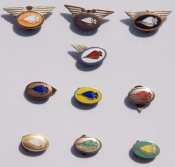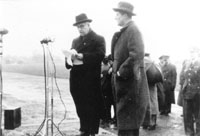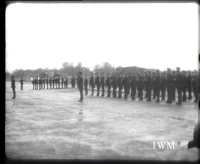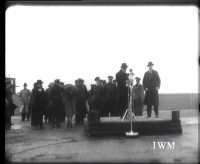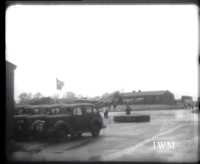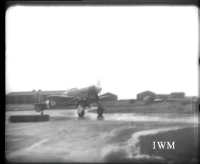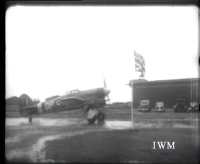RAF HARROWBEER
YELVERTON
Fellowship of the Bellows of Brazil
Having received many
enquiries about this organisation, I felt it was time they had their own Page.
The information below comes from books and research by those named below.
It is presented very much as it was received, with only some general editing.
Stephen Fryer
A brief history of the "Fellowship of the Bellows of Brazil"
Sent in by Paulo Pinotti (with additions from an article in Time Magazine)
After the outbreak of WW2, some British citizens living in Brazil, looked for a way to help the UK in the war. They created the "Spitifire Fund", with the main aim being to raise donations from public subscriptions to buy Spitifires for the RAF. The aircraft bought with these donations were named according to who raised the funds and this was painted (in regulation 4 inch letters) in white or yellow on the side of the engine or under the canopy.
In
November 1940, TOM SLOPER (from "Sloper" a famous Brazilian department
store of that time) began a telephone campaign to obtain more donations. This
was a complete success and became known as "Fellowship of the Bellows".
It soon won direct help from Thomas Impy and Lionel Cole, (Board members of
the Brazilian Telephone Company)
The main body of the group were
students and shop workers. Each member of the "Bellows" paid a monthly
subscription. The club eventually reach ten Brazilian States and in 1942 raised
the amount of 80.000 sterling pounds.
Until January 1943 about 10 Sptifires were bought, some MK V and other MK
IX.
August 2007: updated December 2017
Following a small item broadcast on one of our local radio stations (BBC Radio Devon) I was contacted by Judy Goldup, who told me that her Father had been a member of the "Bellows of Brazil" whilst living in Brazil. He spent his entire working life there, working for the Bank of London and South America. Although only a young girl at the time, she remembered her Father wearing label badges with the 'Bellows' Symbol on, and that depending on the level of monies raised, you got a different design of badge.
They have now donated the badges to the Harrowbeer Interest Group. We would like to express our thanks for this generous donation. It's lovely to think that the money raised to attain these badges, paid for aircraft that flew from Harrowbeer.
The following is additional information taken from an article in Time Magazine, first published on Monday, Dec. 30, 1940. My thanks to Jerry Brewer who spotted it!
"Whiffs, Puffs and Snuffs"
"Casually, but with the instinct of an oldtime newspaperman making a scoop, Lord Beaverbrook referred last week in his report on British aircraft production to a new British fighter: the Whirlwind (specifications still secret). And he stated: "All the fighters and all the bombers that we lost during the months the battle has raged over Britain have been paid for in full, completely and entirely, by public subscription."
That new name and that proud statement brought gusty joy to a hilarious new sodality lately war-born in, of all places, the Argentine. In Buenos Aires two months ago a group of young Britons and Anglo-Argentines, mostly junior executives in Ernst, Berg & Cia. (advertising agency), formed, half in fun and half in earnest, the Fellowship of the Bellows. Aim: "to raise the wind" for purchasing Hurricane and other fighter planes for the R. A. F. Method: each member contributes one Argentine centavo (4¢) for each Axis plane downed during the month. Thus, in October the Fellowship's 3,000 members each paid in 288 centavos or 2.88 pesos (72¢) for the 288 enemy planes notched up by the R. A. F. that month. This totaled some $2,100 or just over £500. By the end of November the membership was 15,000. The November score was 293 enemy planes, the take better than £2,500. (A Hurricane or Spitfire costs about £5,000.) By the end of December the Buenos Aires boosters expect 20,000 members. Meantime their Fellowship of the Bellows has blown into Uruguay, Paraguay, Chile.
Aside from willingness to contribute, prime requisite for F. o. B. membership is to be "a fellow being with a bellow feeling" to enjoy windy punning and complex ritual. Payment of one peso initiation fee makes the joiner a Whiff (all non-joiners are Snuffs, ritualistically defined as "infinitely worse than a cross-eyed toad with athlete's foot"). A Whiff becomes a Puff when he pays his first month's levy. A Puff becomes a Gust when, after his entry, 1,000 planes have been shot down and he has paid in ten pesos. When 5,000 planes are down and 50 pesos paid in, a Gust becomes a Hurricane. When 10,000 planes are down and 100 pesos paid, the Order of the Bellows is bestowed. But no joiner may "blow himself to Puffdom and other exalted ranks" by prepayment or overpayment of dues. All contributions are gladly accepted but the contributor's promotion can proceed only at the pace set for him by the R. A. F. after he signs up.
Servants of the Bellows, "to be blown into office annually unless blown out," are High Wind (President) William Rumboll of Ernst, Berg & Cia.; Whirlwinds (Secretaries) George Ward and Alan Murray, both of London & South American Investment Trust; Receiver of Windfalls (Treasurer) and Keeper of the Windbag (Assistant Treasurer) Colin Shearer and George Collins, respectively."
|
Serial |
Name |
Code |
Donator |
Type |
Baptism |
|
BM161 |
Botafoga |
ZT- |
Rio(Rj) |
Vb |
06/42 |
|
BM634 |
O Bandeirante |
JU- |
São Paulo |
Vb |
06/42 |
|
BS545 |
O Guanany |
MT- |
São Paulo |
IX C |
11/42 |
|
BS546 |
BRAZIL 1 |
MT-J |
Frater Fole |
IX C |
10/42 |
|
JG875 |
Bem-Te-Vi |
? |
Rio (Rj) |
Vc |
10/42 |
|
EP166 |
O Bandeirante |
JU-N |
? |
Vb |
06/42 |
|
? |
Brazil 2 |
? |
Frater Fole |
? |
11/42 |
|
? |
Brazil 3 |
? |
Frater Fole |
? |
11/42 |
|
? |
Brazil 4 |
? |
Frater Fole |
? |
04/43 |
|
? |
Brazil 5 |
? |
Frater Fole |
? |
04/43 |
EP166 flew with 111 squadron
"BS546 flew with 122 squadron, BS545 although had a code MT from 122,
I never could confirm." (says Paulo)
In 1943 the funds were applied for the acquisition of Hawker Typhoon fighters and a complete squadron was equiped. 193 squadron received those fighters.
Finally in March, British Prime Minister Winston CHURCHILL and Brazilian Air Minister Mr. SALGADO FILHO, received the title of " Fellowship Honorable Members.
The Typhoons for 193 Squadron in 1943 were:
|
Serial No |
Sqdn Code |
|
DN267 |
DPB |
|
DN256 |
|
|
MN252 |
DPM |
|
MN926 |
DPJ |
|
RB227 |
DPP |
|
RB254 |
DPU |
|
MN886 |
DPE |
|
MP185 |
DPZ |
|
SW493 |
DPS |
|
JP802 |
|
|
MN712 |
DPB(?) |
|
MN970 |
DPR |
|
JP919 |
DP |
|
PD500 |
DPS(?) |
|
EJ967 |
DPD |
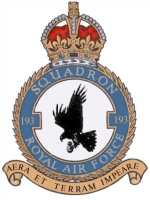 |
193 Squadron CrestThe moto translates as: "To govern the air and the earth" © Crown Copyright
is reproduced with the permission of the |
A Brief History of 193 Squadron (repeated on the 193 Squadron page)
193 Squadron originally formed as a training squadron in WWI but to all intents and purposes, it re-formed at RAF Harrowbeer in September 1943. According to the Squadron's ORB, its early days were marked by a lack of pilots, and planes! New arrivees were forced into borrowing aircraft from other squadrons just to get flying practice. Eventually, the Squadron took delivery of the new Typhoon aircraft. (As you will see from the notes of Ed Mckay, these weren't very reliable aircraft to start with and several fatal accidents were recorded against them in the early days.)
After becoming fully operational, the Squadron was tasked with intercepting enemy raiders crossing the Channel and attacking South Coast targets. It also assisted in providing cover for anti-shipping missions and then later on, it was used in the fighter-bomer role. Once the war in Europe moved away from the Channel, 193 moved from RAF Harrowbeer to airfields in France, following the frontline as it moved eastwards. 193 Squadron disbanded in August 1945.
Additional information:
with permission from - http://www.amnesta.net/other/index_mcbride.html
"No. 193 Squadron existed, I believe, during the last war, simply as a training squadron and no records exist now to show the type of aircraft with which it was equipped, nor any of the operations in which it took part. During the demobilization in 1919, the Squadron lapsed again into just a number, and to all intents and purposes it really formed at Harrowbeer [Airfield, near Yelverton, 10 miles north of Plymouth, on the far southwest coast of England] in September 1942, with Typhoon aircraft. [193 Squadron was formed and mostly remained at Harrowbeer until February 20, 1944.]
It was designated one of the "Brazilian" Squadrons in honor of our ally (if such she is), Brazil. The inauguration ceremonies before the Brazilian staff in October 1943 at Harrowbeer are still remembered in the squadron with a great deal of hilarity. The day in question was stormy with a high wind and pouring with rain. A grand parade was held, however, and a number of aircraft handed over with due formality to the squadron, whilst the Ambassador and various other personages of note made speeches suitable to the occasion. A recording unit operated the while, preserving the words of the night for transmission to posterity, and incidentally to Brazil radio.
A ceremonial fly past had been arranged, but due to the appalling weather, it was thought best not to attempt it and as a last resort, the brilliant idea of a solemn "taxi past" the saluting base was formulated. When put into effect, a formulation of nine aircraft came weaving up the field, strung out in a Vic [an inflexible V-shape that was the RAF's standard tactical fighter formation until it was outmoded in the spring of 1941], past the ranks of rain soaked ground-staff and the very important personages; the whole unimpressive show being totally marred by the fact that one of the wing men, in his frantic effort to keep his position, taxied straight into the recording van and wrote off completely the records of the historic occasion, together with the van, and most of his aircraft. The remaining eight returned without further loss."
Additional information on the above 'accident' from Rod Davidge....
"I recall it was sgt Tommy
Low who ran into a van and also cut the tail off with the prop of another
Typhoon"
News footage of the Presentation ceremony
If you would like to have a copy of the short film shot on the day of the presentation (there were two camera crews at work and only one appears to have been lost as noted above) it is available from the Imperial War Museum Archive. (search for Brazilian Ambassador) It costs approximately 33 UK pounds. Stephen Fryer
|
The Brazilian
Ambassador formally hands over the Typhoons to 193 Squadron on
16th October 1943. The person in front of the microphone is the Ambassador, Mr. Moniz de Aragao. Thanks to Paulo Pinotti |
Additional Information received from Ray Sturtivant
"The Brazilian branch was organised by the British Community in São Paulo. I do not know the total amount donated by the Brazilian branch, but the following Spitfires are known to have been donated:
0 BANDEIRANTE - originally BM634, officially presented to No.111 Sqn on 12 June 1942 at Debden by the Brazilian Ambassador, José Joaquin de Lima E'Silva de Aragao. It crashed 10 days later and was replaced by EP166
0 GUARANY - BS546
BELLOWS BRAZIL No.1 - BS545 (This carried its name on a Bellows motif)
BELLOWS BRAZIL No.II - serial unknown
BELLOWS BRAZIL No.III - serial unknown
BELLOWS BRAZIL No.IV - JL120
BELLOWS BRAZIL No.V - A Mk.V, serial JL???. Presented by the Brazilian Ambassador at RAF Hendon 10.4.43.
BELLOWS BRAZIL No.VI - JL161
There are four other presentation Spitfires, which appear to have Brazilian names and are therefore thought to be Bellows donations. No serials are known for any of them. They are:
CARIOCA, CASCADURA, PALMEIRA and SIERRA DE CARIOCA
I have been told that a Carioca is an inhabitant of Rio de Janeiro. Is this correct?
The Imperial War Museum have quite a number of photogrraphs of some of these aircraft:
O BANDEIRANTE BM634 IWM Photos CH5931, CH5938 & CH5945.
O BANDEIRANTE EP166. IWM Photos CH6825 , CH6826 & CH6827 with Sqn Ldr P.R.Wickham
O GUARANY BS546 IWM Photos CH8162 , CH8163 & CH8164 with P/O G.Le.Gall.
BELLOWS BRAZIL No.I BS545 IWM Photos CH7661 to CH7668, also CH7804 & CH7805 with Bellows emblem.
BELLOWS BRAZIL No.IV JL161 IWM Photo CH9118 to CH9122.
BELLOWS BRAZIL No.V Photos IWM CH9118/9
In addition, the Brazilian Bellows Fund also presented 9 Typhoons to No.193 Squadron at Harrowbeer in 1943. They each had the name BELLOWS BRAZIL painted on them.and included JP918 and JP919. The others are unknown.
Bellows Brazil also donated a Lockheed Hudson. This has been reported as 41-47172 BRITANNIA No.1, and has been stated to have(never received an RAF serial. However, I think US serial 42-47172 is more likely, and this became FK616 .
I have a note that the British Community in Rio de Janeiro subscribed £40,137 for aircraft, being part of a larger effort for naval ships, cables for Government Departments etc. I am not clear whether this was actually part of the Bellows donations, but it included at least two Spitfires, these being:
BM161 BOTAFOGO (said to be named after a fortress overlooking a beach of the same name and means literally "Spit fire" ) .
JG875 BEM-TE-VI (said to be named after a small bird, meaning "I see you")
Ray Sturtivant"
